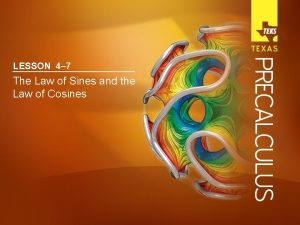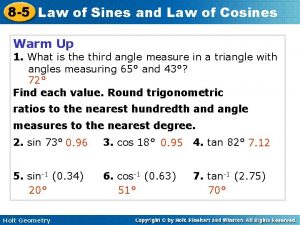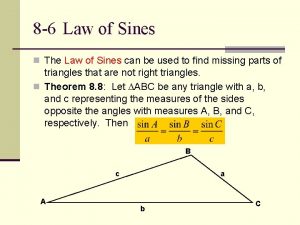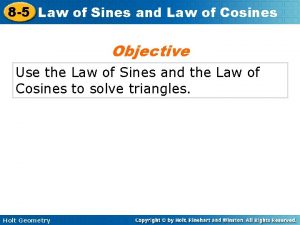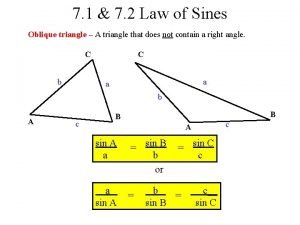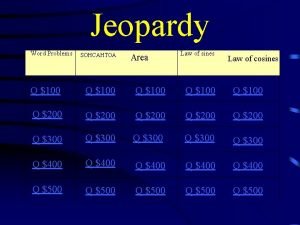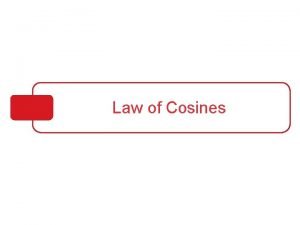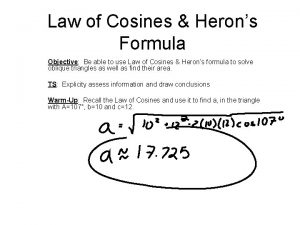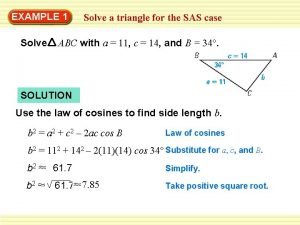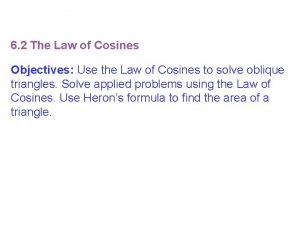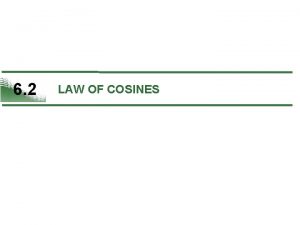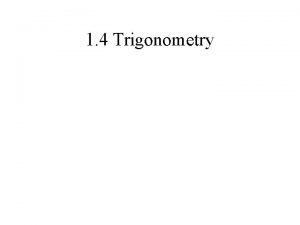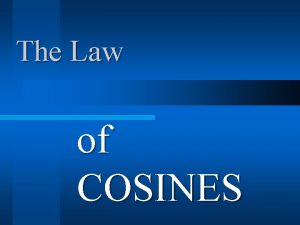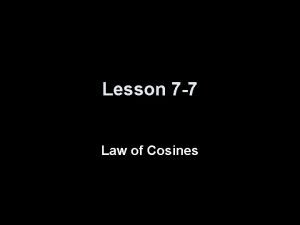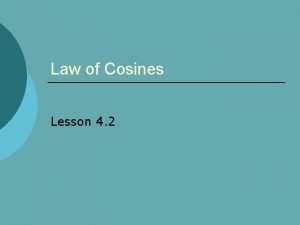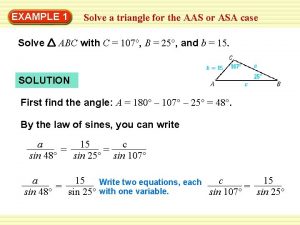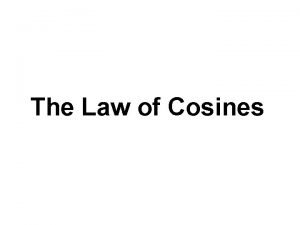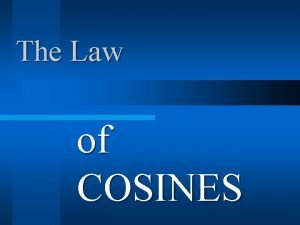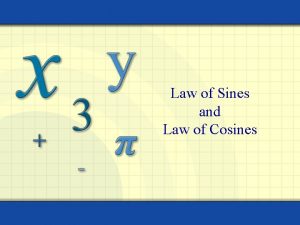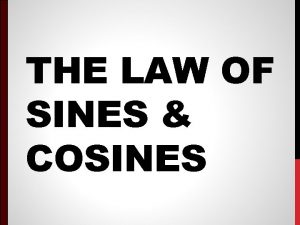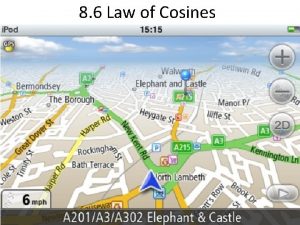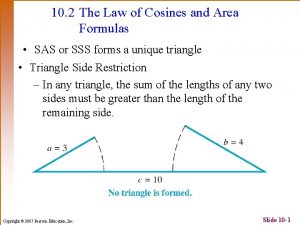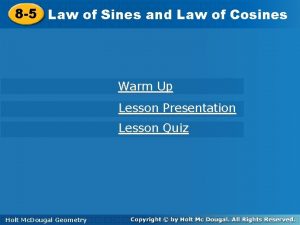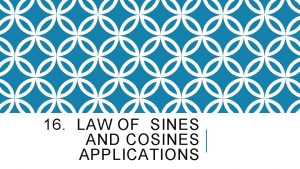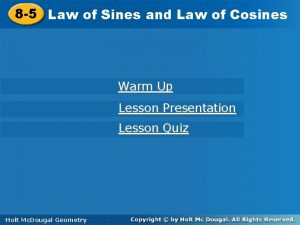EQ What is the law of cosines and


















- Slides: 18

EQ: What is the law of cosines, and how can we use it to solve right triangles? Warm Up Find each measure to the nearest tenth. 1. m y 104° 3. Y ≈ 18. 3 2. x ≈ 8. 8

EQ: What is the law of cosines, and how can we use it to solve right triangles? In the previous lesson, you learned to solve triangles by using the Law of Sines. However, the Law of Sines cannot be used to solve triangles for which side-angle-side (SAS) or side-side (SSS) information is given. Instead, you must use the Law of Cosines.

EQ: What is the law of cosines, and how can we use it to solve right triangles? To derive the Law of Cosines, draw ∆ABC with altitude BD. If x represents the length of AD, the length of DC is b – x.

EQ: What is the law of cosines, and how can we use it to solve right triangles? Write an equation that relates the side lengths of ∆DBC. a 2 = (b – x)2 + h 2 Pythagorean Theorem a 2 = b 2 – 2 bx + x 2 + h 2 Expand (b – x)2. 2 = x 2 + h 2. In ∆ABD, c = – 2 bx + Substitute c 2 for x 2 + h 2. a 2 = b 2 – 2 b(c cos A) + c 2 In ∆ABD, cos A = or x = cos A. Substitute 2 2 2 a = b + c – 2 bccos A c cos A for x. a 2 b 2 c 2 The previous equation is one of the formulas for the Law of Cosines.

EQ: What is the law of cosines, and how can we use it to solve right triangles?

EQ: What is the law of cosines, and how can we use it to solve right triangles? Using the Law of Cosines Use the given measurements to solve ∆ABC. Round to the nearest tenth. a = 8, b = 5, m C = 32. 2° Step 1 Find the length of the third side. c 2 = a 2 + b 2 – 2 ab cos C Law of Cosines c 2 = 82 + 52 – 2(8)(5) cos 32. 2° Substitute. c 2 ≈ 21. 3 c ≈ 4. 6 Use a calculator to simplify. Solve for the positive value of c.

EQ: What is the law of cosines, and how can we use it to solve right triangles? Step 2 Find the measure of the smaller angle, B. Law of Sines Substitute. Solve for sin B. Solve for m B.

EQ: What is the law of cosines, and how can we use it to solve right triangles? Step 3 Find the third angle measure. m A + 35. 4° + 32. 2° 180° m A 112. 4° Triangle Sum Theorem Solve for m A.

EQ: What is the law of cosines, and how can we use it to solve right triangles? Use the given measurements to solve ∆ABC. Round to the nearest tenth. a = 8, b = 9, c = 7 Step 1 Find the measure of the largest angle, B. b 2 = a 2 + c 2 – 2 ac cos B Law of cosines 92 = 82 + 72 – 2(8)(7) cos B = 0. 2857 Substitute. Solve for cos B. m Solve for m B. B = Cos-1 (0. 2857) ≈ 73. 4°

EQ: What is the law of cosines, and how can we use it to solve right triangles? Use the given measurements to solve ∆ABC. Round to the nearest tenth. Step 2 Find another angle measure c 2 = a 2 + b 2 – 2 ab cos C Law of cosines 72 = 82 + 92 – 2(8)(9) cos C Substitute. cos C = 0. 6667 Solve for cos C. m Solve for m C. C = Cos-1 (0. 6667) ≈ 48. 2°

EQ: What is the law of cosines, and how can we use it to solve right triangles? Use the given measurements to solve ∆ABC. Round to the nearest tenth. Step 3 Find the third angle measure. m A + 73. 4° + 48. 2° 180° m A 58. 4° Triangle Sum Theorem Solve for m A.

EQ: What is the law of cosines, and how can we use it to solve right triangles? Use the given measurements to solve ∆ABC. Round to the nearest tenth. b = 23, c = 18, m A = 173° Step 1 Find the length of the third side. a 2 = b 2 + c 2 – 2 bc cos A Law of Cosines a 2 = 232 + 182 – 2(23)(18) cos 173° Substitute. a 2 ≈ 1672. 8 a ≈ 40. 9 Use a calculator to simplify. Solve for the positive value of c.

EQ: What is the law of cosines, and how can we use it to solve right triangles? Step 2 Find the measure of the smaller angle, C. Law of Sines Substitute. Solve for sin C. m C = Sin-1 Solve for m C.

EQ: What is the law of cosines, and how can we use it to solve right triangles? Step 3 Find the third angle measure. m B + 3. 1° + 173° 180° m B 3. 9° Triangle Sum Theorem Solve for m B.

EQ: What is the law of cosines, and how can we use it to solve right triangles? Use the given measurements to solve ∆ABC. Round to the nearest tenth. a = 35, b = 42, c = 50. 3 Step 1 Find the measure of the largest angle, c 2 = a 2 + b 2 – 2 ab cos C C. Law of cosines 50. 32 = 352 + 422 – 2(35)(50. 3) cos C Substitute. cos C = 0. 1560 Solve for cos C. m C = Cos-1 (0. 1560) ≈ 81. 0° Solve for m C.

EQ: What is the law of cosines, and how can we use it to solve right triangles? Use the given measurements to solve ∆ABC. Round to the nearest tenth. a = 35, b = 42, c = 50. 3 Step 2 Find another angle measure a 2 = c 2 + b 2 – 2 cb cos A 352 = 50. 32 + 422 – 2(50. 3)(42) cos A Law of cosines Substitute. cos A = 0. 7264 Solve for cos A. m Solve for m A. A = Cos-1 (0. 7264) ≈ 43. 4°

EQ: What is the law of cosines, and how can we use it to solve right triangles? Step 3 Find the third angle measure. m B + 81° + 43. 4° 180° m B 55. 6° Solve for m B.

EQ: What is the law of cosines, and how can we use it to solve right triangles? Lesson Quiz Use the given measurements to solve ∆ABC. Round to the nearest tenth. 1. a = 18, b = 40, m C = 82. 5° c ≈ 41. 7; m A ≈ 25. 4°; m B ≈ 72. 1° 2. a = 18. 0; b = 10; c = 9 m A ≈ 142. 6°; m B ≈ 19. 7°; m C ≈ 17. 7°
 4-7 law of sines and cosines
4-7 law of sines and cosines 8-6 the law of sines and law of cosines
8-6 the law of sines and law of cosines 8-6 law of sines
8-6 law of sines 8-5 law of sines and law of cosines
8-5 law of sines and law of cosines Find the trigonometric ratio maze answer key
Find the trigonometric ratio maze answer key Oblique triangle
Oblique triangle Sohcahtoa word problems
Sohcahtoa word problems How are the asa case and the saa case differ
How are the asa case and the saa case differ Law of cosines test
Law of cosines test Law of cosines sss
Law of cosines sss Law of cosines formula
Law of cosines formula How to solve a triangle with sas
How to solve a triangle with sas Solving sss triangle
Solving sss triangle Law of cosines sas
Law of cosines sas Law of cosines vectors
Law of cosines vectors Law of cosines example
Law of cosines example 7-7 practice the law of cosines answers
7-7 practice the law of cosines answers Gabe tried to use the law of cosines
Gabe tried to use the law of cosines How to solve a triangle with aas
How to solve a triangle with aas
